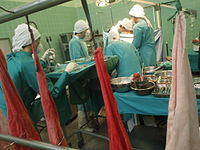
Photo from wikipedia
Purpose The match run is the automated mechanism by which UNOS prioritizes donor hearts to waitlist candidates for heart transplant (HT) based on medical urgency. We sought to determine how… Click to show full abstract
Purpose The match run is the automated mechanism by which UNOS prioritizes donor hearts to waitlist candidates for heart transplant (HT) based on medical urgency. We sought to determine how well match runs perform in sequencing patients according to their medical urgency after implementation of the 2016 pediatric heart allocation revisions. Methods OPTN data were used to identify all match runs between March 21, 2016 and June 9, 2020 for each pediatric donor heart offered through UNOS to US waitlist candidates. The rank-order of candidates on the match run was compared to the rank-order based on medical urgency alone defined as the probability of survival on the day of the match run using a risk prediction model developed and validated during the prior 6 years. Results Overall, 634 donors generated 2,524 unique match runs during the study period when a total of 2,608 candidates were listed for pediatric HT. The median age of donors was 5 years (Q1, Q3, 1, 13), median weight 21 (11, 54) kg with the most common cause of death natural causes (26%), non-motor vehicle accidents (MVA) (22%) and MVA (16%). The risk-prediction model for death or deterioration included 8 variables (age, weight, cardiac diagnosis and cardiac support). When the survival model was applied to the match run candidates within zone, 26% of candidates were ranked out of survival order (i.e. had a rank-reversal) (Table). Of these, 69% of rank-reversals involved candidates within the same UNOS status levels whereas 41% involved candidates spread across UNOS status levels. Conclusion There is evidence to suggest that the 2016 revision to the pediatric donor heart allocation system fails to sequence waitlisted candidates according to medical urgency, which affects a substantial fraction of match runs. Misclassification of patient risk by UNOS status level and within UNOS status levels each contribute rank-reversals. Rank-ordering patients based on a continuous survival probability model could address both problems.
Journal Title: Journal of Heart and Lung Transplantation
Year Published: 2021
Link to full text (if available)
Share on Social Media: Sign Up to like & get
recommendations!